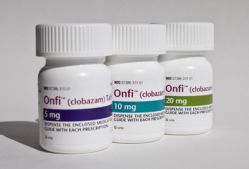Top Class Actions’s website and social media posts use affiliate links. If you make a purchase using such links, we may receive a commission, but it will not result in any additional charges to you. Please review our Affiliate Link Disclosure for more information.

Onfi is part of a newer-generation of seizure medication. The first drugs manufactured to treat epilepsy and other seizure disorders were more general sedatives designed to depress brain activity more broadly. This medical approach was used in the hopes that these drugs would also suppress the errant brain activity that leads to seizures.
As such, first-generation anti-seizure drugs typically had serious side effects, like general sedation and lethargy. Newer drugs like Onfi are designed to be more selective in their action, ideally suppressing seizure activity without leaving the patient feeling drugged. However, according to the FDA’s drug notice, Onfi side effects could include life-threatening autoimmune reactions like Onfi SJS and TEN.
In December 2013, the FDA issued a Drug Safety Communication advising consumers and physicians that Onfi was linked to “rare but serious skin reactions that can result in permanent harm and death.” The announcement went on to elaborate that the FDA had found that some patients taking Onfi had suffered from a related group of serious skin reactions that included SJS and TEN.
Both Stevens Johnson Syndrome (SJS) and Toxic Epidermal Necrolysis (TEN) are part of a spectrum of autoimmune disorders that also includes erythema multiforme and “purple glove syndrome.” All of these reactions are autoimmune disorders, medical conditions wherein the immune system malfunctions and attacks the patient’s own body. In the case of SJS, TEN, and related disorders, the immune system mounts an attack on the largest organ—the skin.
Onfi Stevens Johnson Syndrome and Epidermal Necrolysis Reactions
SJS symptoms start out as generalized, flu-like symptoms like joint aches, fever, and muscle pain. This is because many of the flu’s symptoms are caused by the immune system ramping up to fight the virus—though in the case of SJS, this same system is mistaking the skin for an invading germ. However, SJS symptoms rapidly escalate to a blistering rash with sores and ulcers covering the skin, mouth, and eyes. In some cases, the sores and ulcers even spread to the surface of internal organs, causing impaired organ function. The most extreme cases can develop into a more severe form of the disease, called Toxic Epidermal Necrolysis or TEN.
TEN is a particularly severe form of SJS. When SJS becomes TEN, the sores give way to large patches of skin dying and sloughing off, leaving wounds almost identical to severe thermal burns. The damage is so similar that hospitals often move TEN patients to their burn wards to treat the disease. The mortality rate is dependant on the severity of the reaction, but TEN patients generally have a mortality rate of 30 to 40 percent, higher than some strains of the Ebola virus.
Due to the relative rarity of SJS and TEN, many mysteries remain about the exact nature of these allergic skin reaction disorders. However, it is known that a strong majority of cases of SJS and TEN are triggered by drugs like Onfi.
While Onfi SJS and TEN are relatively rare, that’s small consolation to the patients who suffer these reactions. Even survivors face debilitating, crippling complications, including permanent organ damage, blindness, and disfiguring and disabling scarring across their bodies. Because of the extreme bodily damage and emotional and mental trauma, many Onfi SJS and TEN victims choose to file Onfi SJS lawsuits or join an Onfi class action lawsuit.
Do YOU have a legal claim? Fill out the form on this page now for a free, immediate, and confidential case evaluation. The Stevens Johnson Syndrome attorneys who work with Top Class Actions will contact you if you qualify to let you know if an individual lawsuit or class action lawsuit is best for you. [In general, SJS lawsuits are filed individually by each plaintiff and are not class actions.] Hurry — statutes of limitations may apply.
ATTORNEY ADVERTISING
Top Class Actions is a Proud Member of the American Bar Association
LEGAL INFORMATION IS NOT LEGAL ADVICE
Top Class Actions Legal Statement
©2008 – 2024 Top Class Actions® LLC
Various Trademarks held by their respective owners
This website is not intended for viewing or usage by European Union citizens.
Get Help – It’s Free
Help for Victims of Onfi Stevens Johnson Syndrome
If you or a loved one were diagnosed with Stevens Johnson Syndrome (SJS) or toxic epidermal necrolysis (TEN) after taking Onfi, you may be eligible to take legal action against the drug’s manufacturer. Filing an Onfi SJS lawsuit or Onfi class action lawsuit may help you obtain compensation for medical bills, pain and suffering, and other damages. Obtain a free and confidential review of your case by filling out the form below.
An attorney will contact you if you qualify to discuss the details of your potential case at no charge to you.
Oops! We could not locate your form.












